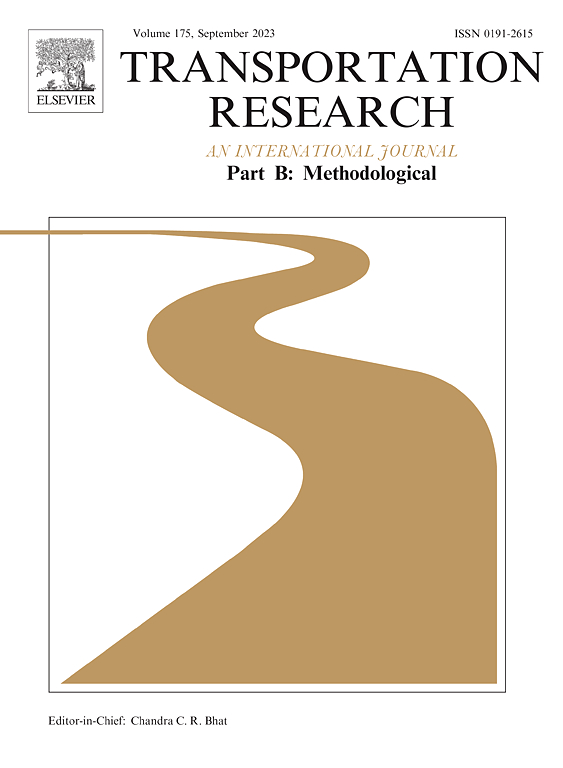Unveiling network capacity potential with imminent supply information part II: Backpressure-based validation
IF 5.8
1区 工程技术
Q1 ECONOMICS
引用次数: 0
Abstract
The capacity region (CR) is a key index to characterize a dynamic processing system’s ability to handle incoming demands. It is a multidimensional space when the system has multiple origin–destination pairs where their service rates interact. An urban traffic network is such a system. Traffic congestion appears when its demand approaches or exceeds the upper frontier of its CR. Part I of this study theoretically proved that (1) accurate I-SFR information of additional conflicting movements can enlarge the CR, and (2) improving the I-SFR prediction accuracy of observed movements can expand the CR. However, such expansion has not been validated through experiments. Part II of this study thus focuses on validating the theoretical findings in Part I. We use a real-time traffic control policy, named BackPressure (BP) control, to act as a ruler to measure the size of CR. We first prove that BP policy with partial I-SFR information can stabilize the network within the corresponding CR. Then we design various calibrated simulation experiments to check the validity of the two findings in Part I. Specifically, we use reserve demand, which represents the distance between a given demand and the frontier of CR, as a direct index to reflect the size of CR, and use delay as an indirect index to reflect the changes in CR. Simulation results confirm the theories in Part I.
揭示网络容量潜力与迫在眉睫的供应信息第二部分:基于反压力的验证
容量区域(CR)是表征动态处理系统处理传入需求能力的关键指标。当系统具有多个始发-目的地对,并且它们的服务费率相互作用时,它是一个多维空间。城市交通网络就是这样一个系统。本研究第一部分从理论上证明了:(1)准确的附加冲突运动的I- sfr信息可以扩大CR,(2)提高观测运动的I- sfr预测精度可以扩大CR,但这种扩大尚未得到实验验证。因此,本研究的第二部分重点是验证第一部分的理论发现,我们使用实时交通控制策略BackPressure (BP) control作为衡量CR大小的标尺,我们首先证明了具有部分I-SFR信息的BP策略可以在相应的CR内稳定网络,然后我们设计了各种校准的模拟实验来检验第一部分中两个发现的有效性。表示给定需求与CR边界之间的距离,作为反映CR大小的直接指标,并使用延迟作为反映CR变化的间接指标。仿真结果证实了第一部分的理论。
本文章由计算机程序翻译,如有差异,请以英文原文为准。
求助全文
约1分钟内获得全文
求助全文
来源期刊
CiteScore
12.40
自引率
8.80%
发文量
143
审稿时长
14.1 weeks
期刊介绍:
Transportation Research: Part B publishes papers on all methodological aspects of the subject, particularly those that require mathematical analysis. The general theme of the journal is the development and solution of problems that are adequately motivated to deal with important aspects of the design and/or analysis of transportation systems. Areas covered include: traffic flow; design and analysis of transportation networks; control and scheduling; optimization; queuing theory; logistics; supply chains; development and application of statistical, econometric and mathematical models to address transportation problems; cost models; pricing and/or investment; traveler or shipper behavior; cost-benefit methodologies.

 求助内容:
求助内容: 应助结果提醒方式:
应助结果提醒方式:


